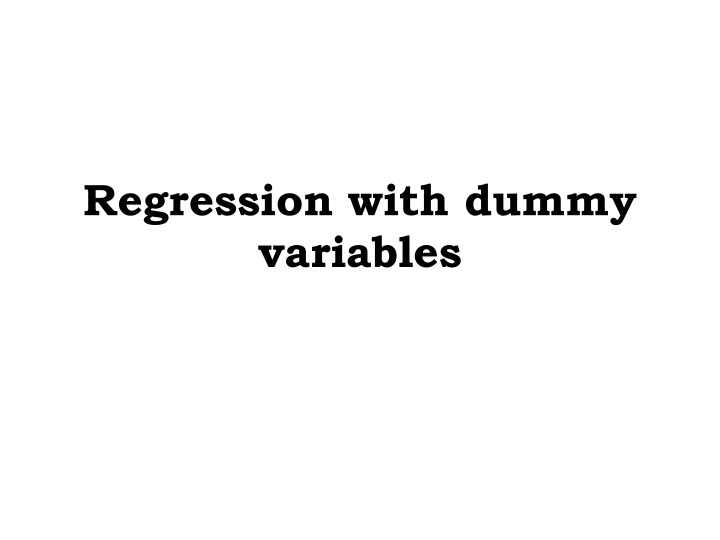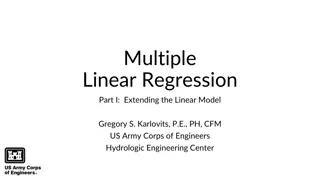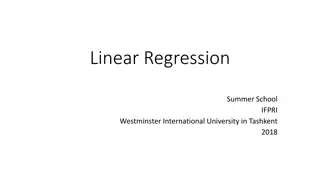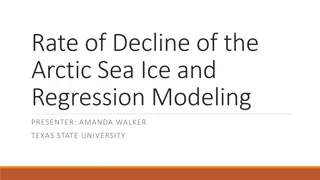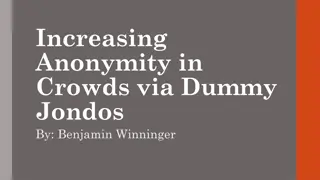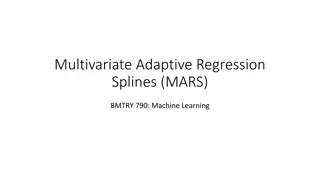Regression with Dummy Variables
Dummy variables in regression models are used to indicate the presence or absence of certain qualities or attributes, such as gender or ethnicity. They help classify data into exclusive categories, and caution must be taken to avoid issues like the dummy variable trap. Interpretations of regression results involving dummy variables can provide insights into the differential effects of various factors on the outcome variable.
Download Presentation

Please find below an Image/Link to download the presentation.
The content on the website is provided AS IS for your information and personal use only. It may not be sold, licensed, or shared on other websites without obtaining consent from the author.If you encounter any issues during the download, it is possible that the publisher has removed the file from their server.
You are allowed to download the files provided on this website for personal or commercial use, subject to the condition that they are used lawfully. All files are the property of their respective owners.
The content on the website is provided AS IS for your information and personal use only. It may not be sold, licensed, or shared on other websites without obtaining consent from the author.
E N D
Presentation Transcript
Regression with dummy variables
dummy variables as explanatory vars. Dummy variables indicate the presence or absence of a quality or an attribute, such as male or female, black or white, Catholic or non- Catholic, Democrat or Republican, they are essentially nominal scale variables. One way we could quantify such attributes is by constructing artificial variables that take on values of 1 or 0, 1 indicating the presence (or possession) of that attribute and 0 indicating the absence of that attribute. For example 1 may indicate that a person is a female and 0 may designate a male; or 1 may indicate that a person is a college graduate, and 0 that the person is not, and so on. Variables that assume such 0 and 1 values are called dummy variables. Such variables are thus essentially a device to classify data into mutually exclusive categories such as male or female.
Cond Dummy variables can be incorporated in regression models just as easily as quantitative variables. Caution in the Use of Dummy Variables If a qualitative variable has m categories, introduce only (m 1) dummy variables. Unless there may happen dummy variable trap, that is, the situation of perfect collinearity or perfect multicollinearity, Thus, For each qualitative regressor the number of dummy variables introduced must be one less than the categories of that variable.
Cond The category for which no dummy variable is assigned is known as the base, benchmark, control, comparison, reference, or omitted category. And all comparisons are made in relation to the benchmark category. The intercept value represents the mean value of the benchmark category. The coefficients attached to the dummy variables are known as the differential intercept coefficients because they tell by how much the value of the intercept that receives the value of 1 differs from the intercept coefficient of the benchmark category. If a qualitative variable has more than one category the choice of the benchmark category is strictly up to the researcher.
Regression with dummy variables: interpretations Suppose one estimates determinants of wage differentials (logarism of wage: lwage) using education (years of schooling), black(dummy) and south dummy Source SS df MS Number of obs = 3,010 F(3, 3006) = 215.54 Model 104.913108 3 34.9710362 Prob > F = 0.0000 Residual 487.728503 3,006 .162251664 R-squared = 0.1770 Adj R-squared = 0.1762 Total 592.641611 3,009 .196956335 Root MSE = .4028 lwage Coef. Std. Err. t P>|t| [95% Conf. Interval] educ .0381368 .0028695 13.29 0.000 .0325104 .0437632 black -.1902245 .0189161 -10.06 0.000 -.2273142 -.1531348 south -.1586304 .0160378 -9.89 0.000 -.1900766 -.1271842 _cons 5.864466 .0409799 143.11 0.000 5.784114 5.944817 Coefficient of black: citrus paribus, black households earn 19% less wage than white households.
REGRESSION MODELS FOR CATEGORICAL DEPENDENT VARIABLES
Models for Binary Outcomes Regression models for binary outcomes allow a researcher to explore how each explanatory variable affects the probability of the event occurring. the two most frequently used models are: the binary logit and binary probit models, referred to jointly as the binary regression model (BRM). In the statistical model for binary logit and probit, there are three ways to derive the BRM, with each method leading to the same mathematical model: a. An unobserved or latent variable can be hypothesized along with a measurement model relating the latent variable to the observed, binary outcome. b. The model can be constructed as a probability model. c. The model can be generated as random utility or discrete choice model.
Cond Requirements for binary regression: An outcome variable with two possible categorical outcomes (1=success; 0=failure). A way to estimate the probability p of the outcome variable: If p is the probability of an event, then (1-p) is the probability of it not occurring. A way of linking the outcome variable to the explanatory variables. A way of estimating the coefficients of the regression equation. A way to test the goodness of fit of the regression model.
Cond Assumptions: The outcome must be discrete. Distributional assumptions of errors If the outcome is continuous then multiple regression is more powerful given that the assumptions are met. Linearity in the logit/probit
Linear probability model (LPM) One of the simplest methods of analyzing binary outcome data is the Linear Probability Model ((LPM). It is a linear regression model with a dependent variable that is either 0 or 1. The LPM predicts the probability of an event occurring, and, like other linear models, says that the effects of X's on the probabilities are linear.
Cond LPM allows the model to be fitted by multiple linear regression (MLR) model. The model assumes that, for a binary outcome ,y, and its associated vector of explanatory variables, x: LPM has many limitations including the following No normality of errors Heteroscedastic errors Fallacious predictions A downward bias in the coefficient of determination
The logit model Logistic regression is often used because the relationship between the discrete variable and a predictor is nonlinear. Picture of binary regression: non-linear slope coefficient
Cond The LPM and BLM are compared in the following figure.
The probit model The Logit model is only one way of modeling binary choice data. It is actually more used than logit models and assumes a normal distribution (not a logistic one). An alternative CDF to that used in the BLM is the normal CDF, when this is used we refer to it as the probit model. In many respects this is very similar to the logit model. The binary probit model (BPM) has also been interpreted as a latent variable model. The coefficient estimates from all three models (LPM, BLM and BPM) are related. The probit model is
Computer Lab: Estimation and interpretation of binary outcome models Consider the dataset adoption_commercialization. Based on the dataset, estimate the probit and logit model for households market participation decision (comcrp) in crop output markets. Suppose the explanatory variables are farming system, sex of the household head, family size, farming experience, land holding, quantity of fertilizer used, asset holdings (log), distance to town and development station. a. Which factors do determine market participation? b. Which binary model of market participation is fittest? c. What is the likelihood of producers to participate in the crop output markets?
The probit model outputs suggest that farming system, sex, fertilizer used, and distance to town are significant factors of crop market participation. Similar factors are found to be significantly affecting market participation in the logit model. The probability of households to participate in the crop markets is nearly identical (57.6% in the probit and 58.3% in the logit). The model validation statistics are also nearly similar. However, as indicated by the goodness-of-fit (gof) tests after probit and logit, the null that the model is fittest is rejected at 5% level in the logit model, suggesting that the errors in the logistic regression are not logistically distributed. The market participation decision of households in this case is best explained by the probit model because the assumption of normality of the errors is supported by the gof test.
Models for Nominal Outcomes: Multinominal logit
Cond An outcome is nominal when the categories are assumed to be unordered. For example, marital status can be grouped nominally into the categories of divorced, never married, married, or widowed. Occupations might be organized as professional, white collar, blue collar, craft, and menial. The multinomial logit (MNL) model is the most frequently used nominal regression model. In this model, the effects of the independent variables are allowed to differ for each outcome.
Cond If the multinomial logit is used to model choices, it relies on the assumption of independence of irrelevant alternatives (IIA) which is not always desirable. This assumption states that the odds do not depend on other alternatives that are not relevant (e.g. the relative probabilities of taking a car or bus to work do not change if a bicycle is added as an additional possibility). If the multinomial logit is used to model choices, it may in some situations impose too much constraint on the relative preferences between the different alternatives. This point is especially important to take into account if the analysis aims to predict how choices would change if one alternative was to disappear. Other models like the nested logit or the multinomial probit may be used in such cases as they need not violate the IIA.
Cond In the case of four choices, one could first perform three logistic regressions as follows: Where m=1 = outcome 1, m=2 = outcome 2n, m=3 = outcome 3 The multinomial model is a simultaneous (as opposed to sequential) estimation model comparing the odds of each category with respect to all others.
Cond The syntax mlogit fits maximum-likelihood multinomial logit models, also known as polytomous logistic regression. We can define constraints to perform constrained estimation. The command mfx compute, at(mean depvar=#) computes the marginal effects and the probabilities of the outcome at the mean value. The command predict varname, outcome(#) p predicts the probability of each outcome, where # indicate the outcome. The mean value of the predicted probabilities for all the outcomes can then be summarized and reported.
The multinomial probit (MNP) model is used with discrete dependent variables that take on more than two outcomes that do not have a natural ordering. The stochastic error terms for this implementation of the model are assumed to have independent, standard normal distributions. The syntax mprobit fits MNP models via maximum likelihood. depvar contains the outcome for each observation, and indepvars are the associated covariates. The error terms are assumed to be independent, standard normal, random variables. The command mfx compute, at(mean depvar=#) computes the marginal effects and the probabilities of the outcome at the mean value. The command predict varname, outcome(#) p predicts the probability of each outcome, where # indicate the outcome. The mean value of the predicted probabilities for all the outcomes can then be summarized and reported.
Computer Lab: Estimation, interpretation and tests of nominal outcome models 1. Consider the database erhs_r7 to estimate the multinomial logit model of determinants of marital status (marit2) in rural Ethiopia. There are three outcomes of the dependent variable defined as marital status (1 if married, 2 if widowed, 3 if divorced or never married). Suppose the variables affecting marital status schooling measured as grade completed, poverty status, livestock holding, low income ladder, high income ladder, and regional dummies (Amhara, Oromia, Tigray, Southern region). Estimate the MNL model with different base categories and interpret the model outputs. Estimate the marginal effects for each outcome. Predict the probability of each outcome and interpret the results. 2. Consider the same database used in the MNL model erhs_r7 to estimate the MNP model of marital status in rural Ethiopia. Also use the same set of explanatory variables. Estimate and interpret the MNP model outputs. Estimate the marginal effects for each outcome. Predict the probability of each outcome and compare them with the predictions from the MNL model outputs. Compute the marginal effects and probability of marital status across administrative regions in rural Ethiopia. are age, household size, formal
The MNP model outputs reported below are nearly similar to the outputs in the MNL model.
Models for Ordinal Outcomes An ordered probit/logit model is used to estimate relationships between an ordinal dependent variable and a set of independent variables. An ordinal variable is a variable that is categorical and ordered, for instance, poor , good , and excellent , which might indicate the fertility levels of soil for crop production. This entry is concerned only with more than two outcomes. If the outcomes cannot be ordered, the ordered probit/logit model cannot be used. In ordered probit/logit, an underlying score is estimated as a linear function of the independent variables and a set of cutpoints. The probability of observing outcome i corresponds to the probability that the estimated linear function, plus random error, is within the range of the cutpoints estimated for the outcome.
Cond To illustrate the measurement model, consider people are asked to respond to the following statement: Land fragmentation is the major problem of crop productivity among smallholder farmers in Ethiopia Possible responses are: 1=Strongly disagree (SD), 2=Disagree (D), 3=Agree (A), and 4=Strongly agree (SA). Thus, when the latent y* crosses a cut point, the observed category changes.
Cond The interpretation is that Outcome will be in the second ordered category or higher (not the first), if Outcome will be in the third ordered category or higher (not the first or second), if
Computer Lab: Application and analysis of ordinal outcome models Consider the database erhs_r7 in order to estimate the ordered model of life status of households (life) in rural Ethiopia by using their perceived ladder of life. The households are categorized by their ladder of life in the 10 ladders of life as 1 if at low ladder (ladders 0- 3), 2 if at middle ladder (ladders 4-6), or high if at highest ladders (ladders 7-10). The factors determining life status in rural Ethiopia are assumed to be age, marital status, household size, grades completed, poverty status, livestock holding, and regional dummies (Amhara, Oromia, Tigray and SNNP). a. Estimate and interpret the ordinal probit model outputs. b. Estimate the marginal effects for each outcome. c. Predict the probability of each outcome and interpret them. d. Compute the marginal effects and probability of life status across administrative regions in rural Ethiopia.
Cond The likelihood of households in rural Ethiopia to live in the lowest, middle and highest ladders of life, respectively, is 32.3%, 54.2% and 13.5%. The majority of households are likely to live in the middle ladders of life (54.2%). The probability of households in rural Ethiopia to live in the highest ladders of life is very much limited (only 13.5%).
